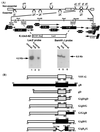Pseudotyping of glycoprotein D-deficient herpes simplex virus type 1 with vesicular stomatitis virus glycoprotein G enables mutant virus attachment and entry
- PMID: 10666285
- PMCID: PMC111736
- DOI: 10.1128/jvi.74.5.2481-2487.2000
Pseudotyping of glycoprotein D-deficient herpes simplex virus type 1 with vesicular stomatitis virus glycoprotein G enables mutant virus attachment and entry
Abstract
The use of herpes simplex virus (HSV) vectors for in vivo gene therapy will require the targeting of vector infection to specific cell types in certain in vivo applications. Because HSV glycoprotein D (gD) imparts a broad host range for viral infection through recognition of ubiquitous host cell receptors, vector targeting will require the manipulation of gD to provide new cell recognition specificities in a manner designed to preserve gD's essential role in virus entry. In this study, we have determined whether an entry-incompetent HSV mutant with deletions of all Us glycoproteins, including gD, can be complemented by a foreign attachment/entry protein with a different receptor-binding specificity, the vesicular stomatitis virus glycoprotein G (VSV-G). The results showed that transiently expressed VSV-G was incorporated into gD-deficient HSV envelopes and that the resulting pseudotyped virus formed plaques on gD-expressing VD60 cells, albeit at a 50-fold-reduced level compared to that of wild-type gD. This reduction may be related to differences in the entry pathways used by VSV and HSV or to the observed lower rate of incorporation of VSV-G into virus envelopes than that of gD. The rate of VSV-G incorporation was greatly improved by using recombinant molecules in which the transmembrane domain of HSV glycoprotein B or D was substituted for that of VSV-G, but these recombinant molecules failed to promote virus entry. These results show that foreign glycoproteins can be incorporated into the HSV envelope during replication and that gD can be dispensed with on the condition that a suitable attachment/entry function is provided.
Figures



References
-
- Akkaraju G R, Huard J, Hoffman E P, Goins W F, Pruchnic R, Watkins S C, Cohen J B, Glorioso J C. Herpes simplex virus vector-mediated dystrophin gene transfer and expression in MDX mouse skeletal muscle. J Gene Med. 1999;1:280–289. - PubMed
-
- Banfield B, Leduc Y, Esford L, Visalli R, Brandt C, Tufaro F. Evidence for an interaction of herpes simplex virus with chondroitin sulfate proteoglycans during infection. Virology. 1995;208:531–539. - PubMed
-
- Butcher M, Raviprakash K, Ghosh H P. Acid pH-induced fusion of cells by herpes simplex virus glycoproteins gB and gD. J Biol Chem. 1990;265:5862–5868. - PubMed
Publication types
MeSH terms
Substances
Grants and funding
LinkOut - more resources
Full Text Sources
Other Literature Sources

